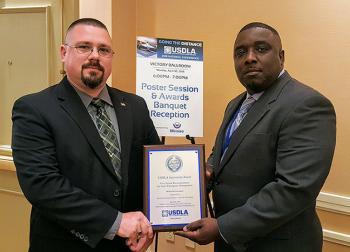
Applied Research Associates, Inc. (ARA), has earned one of the world’s most prestigious distance learning awards for the Post Attack Reconnaissance (PAR) training course it developed for the US Air Force.
The course is used to train and certify US Airmen in PAR, or what to do in the event of a chemical, biological, nuclear, radiological or explosive attack on an air base. It uses images and video from real-world and training events involving Air Force personnel in actual reconnaissance environments to add an unparalleled course that is the first of its kind to target installation personnel.
This year ARA, in partnership with the Air Force Civil Engineer Center (AFCEC) at Tyndall Air Force Base, is one of only three winners of the United States Distance Learning Association (USDLA) Innovation Award and the only government/military winner. The awards were handed out April 30 in Indianapolis.
“THIS YEAR’S USDLA AWARD RECIPIENTS REPRESENT THE FINEST EXAMPLES OF ONLINE COURSES, BEST PRACTICES, AND LEADERSHIP IN OUR FIELD.” – PAT CASSELLA, USDLA PRESIDENT
The USDLA Awards were created to acknowledge major accomplishments in distance learning and to highlight those distance learning instructors, programs, and professionals who have achieved and demonstrated extraordinary results through the use of online, video conferencing, satellite and blended learning delivery technologies.
AFCEC wanted a departure from the old PowerPoint-based training classes of the past to give students an engaging, input driven, immersive learning environment. Because national data shows 97 percent of US teens play video games, AFCEC training experts wanted to create a scenario-based training environment that emulates gameplay of popular console games to improve training retention of new Airmen.
AFCEC selected ARA’s PAR course to deploy this new training innovation. The course aims to identify the purpose of PAR teams, understand the policies and directives governing them, know how PAR teams fit into the incident command structure, and be fully aware of their roles and responsibilities as PAR team members.
The still imagery and videos, combined with additional animation and narration, create an engaging instructional module. The subsequent immersive training environment features a responsive 3D setting that simulates conventional and chemical attacks in pre- and post-attack missions.




